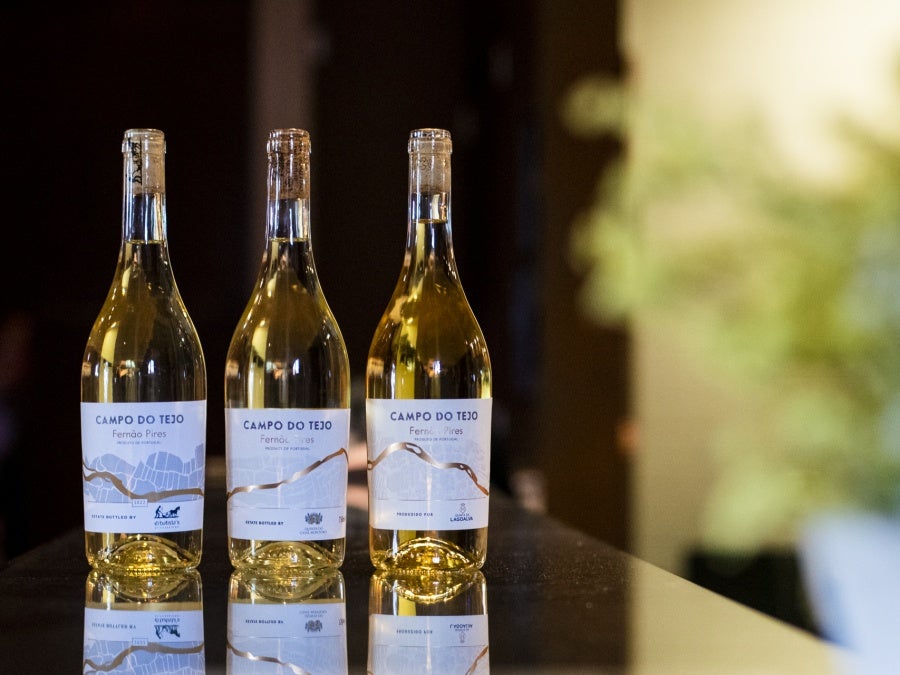
Campo do Tejo, a wine category created by Portuguese trade body Wines of Tejo (CVRT), is targeting the low- and no-alcohol category and wider “wellness” trend, its founders have said.
Launched last month, the first range is made up of white wines from three producers within the Tejo region that are light in style and lower in alcohol than the average.
A region known for its red wines, the aim of the project is to promote Tejo’s white wines, which are made predominantly from indigenous grape Fernão Pires.
The CVRT hopes to grow the category to include around ten producers in future vintages.
“It’s an exciting white-wine project because in this region we have a lot of white wine which mainly comes out of the Portuguese grape variety Fernão Pires, which is a very versatile grape,” CVRT president Luis de Castro told Just Drinks.
Not an official appellation, Campo do Tejo’s founders hope to attract new, health-conscious drinkers to the Portuguese wine category.
Wine consultant Brian Howard, the co-founder of Wine Intelligence who helped create and launch the category, said: “The wine has lower alcohol generally than the average of white wines in international markets.
“Most of the wine will be below 12% abv, at 11.5 degrees down to even nine and a half. This puts it in that sweet spot internationally of wines which people would consider more friendly in alcohol terms and more consumable in different wine moments where the pursuit of high alcohol is not what they want to achieve.”
The winemakers are also hoping to attract new drinkers to the category through clear marketing and accessible labels.
“The Portuguese language is very tough for English speakers around the world because we have very difficult words, like Fernão Pires,” de Castro said. “Campo is a Portuguese word but you can understand it.”
Howard added: “One of our driving forces for this development was to create a brand that makes the wine accessible. Hence the name which is, for Portugal, a relatively easy word to say in English.
“We wanted to feature the grape [on the label] but not depend on consumers having to say the grape in order to find the wine. We are aiming at the wider consumer market, rather than those who are heavily engaged in wine.”
The Tejo wine region covers 13,000 hectares of vineyards and produces around 65m litres of wine each year, forming around 10% of Portugal’s total production. Campo is a sub-region within Tejo which spans approximately 80km of land on either side of the Campo river.
To be labelled ‘Campo do Tejo’, wines must have at least 85% Fernão Pires – the remaining 15% can be a blend, but not using Sauvignon Blanc or Muscat, which are considered too overpowering.
CVRT, one of Portugal’s 14 wine commissions, certifies every wine by tasting and lab tests to check they adhere to regulations.
The wines all come in lightweight bottles (under 400g) and will have an environmental “emphasis”, reducing chemical usage in the vineyards and conserving water.
“We’re trying to address all the issues that Wine Intelligence and other research shows have become more significant, partly because of the pandemic, partly because of climate and partly because of the focus of wellness right across all drinks and food categories,” Howard said.
Aimed at both on-premise and off-premise, the wines’ RRP will sit in the €5.99-6.99 RRP ($6.51-7.59) range.
The wines have been launched first into the wider region’s key markets: Brazil, Benelux, China, Germany, Poland, Portugal, Sweden, the UK and the US.
de Castro also has his eyes on the Nordic markets, which he said are “very important”.
He said: “If you are chosen [by one of the region’s alcohol monopolies] you know already that you have a big chain to distribute your wines.”
He added the style of Campo de Tejo wine, and its sustainability credentials, would be well suited to the Nordic countries, several of whom stipulate lightweight packaging must be used for alcoholic beverages.
In the UK, the wines will benefit from duty rises in August, which will see alcoholic products between 8.5% and 22% abv taxed at £28.50 per litre of alcohol. Furthermore, they will avoid extra shorter-term charges for wines between 11.5% and 14.5%.
Howard said Campo de Tejo “takes on more significance” in the UK next month following the duty changes, with buyers now actively looking for sub-11.5% abv wines. “Campo de Tejo will be a significant number of pennies cheaper than a wine such as Picpoul de Pinet which are typically 12.5% abv-13% abv,” he added.
While low-alcohol wine is a growing segment, last week Concha y Toro technical director and winemaker Marcelo Papa said zero-alcohol wine is “a big issue” for the industry. “At the moment, I’m not seeing or tasting any wine that is enjoyable with zero alcohol,” he said.
Concha y Toro has released an 8.5% abv wine, Belight, under its Casillero del Diablo brand, which is available in some Latin American markets and is due to be launched in the UK and Europe next year.



